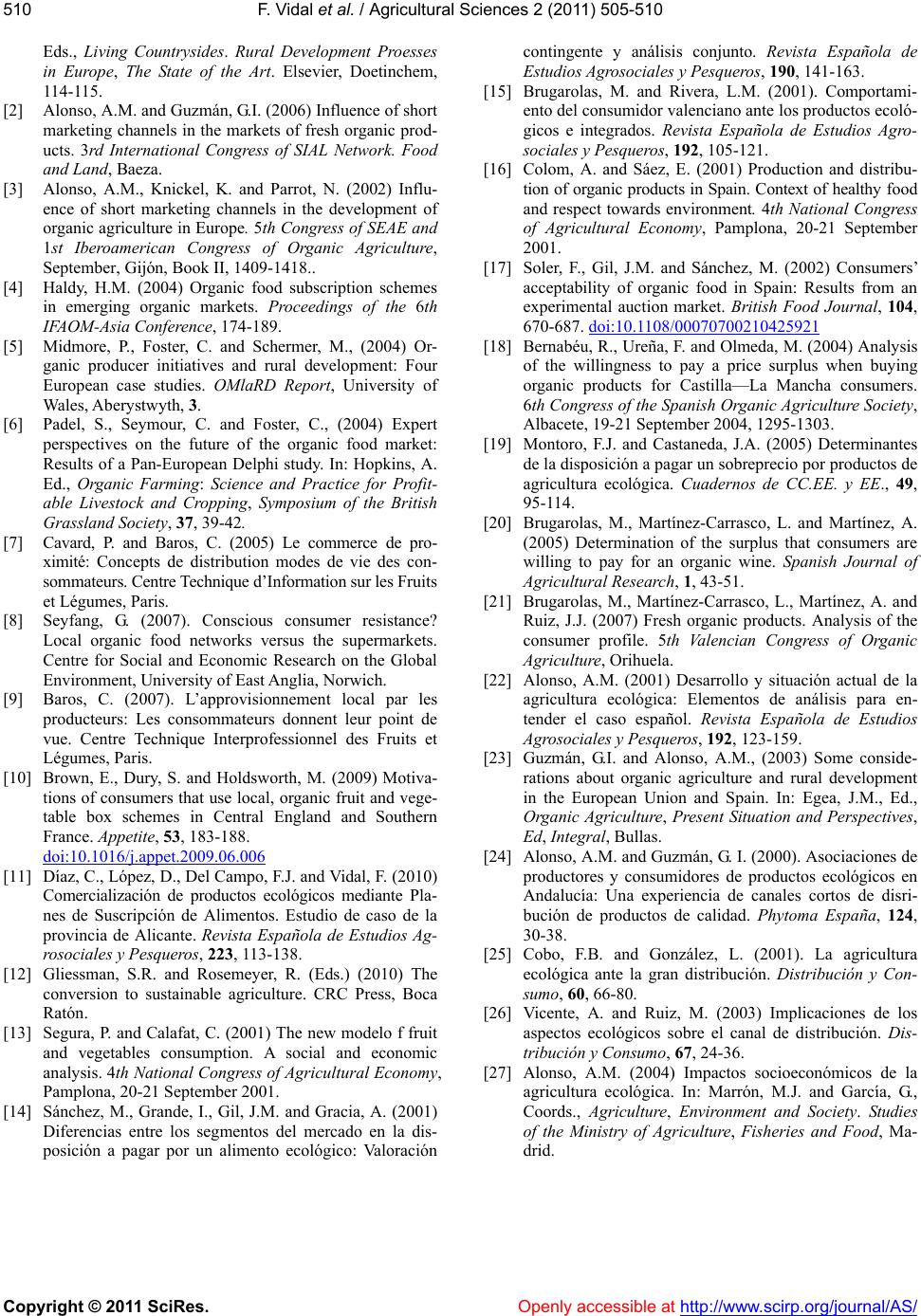
F. Vidal et al. / Agricultural Sciences 2 (2011) 505-510
Copyright © 2011 SciRes. Openly accessible at http://www.scirp.org/journal/AS/
510
Eds., Living Countrysides. Rural Development Proesses
in Europe, The State of the Art. Elsevier, Doetinchem,
114-115.
[2] Alonso, A.M. and Guzmán, G.I. (2006) Influence of short
marketing channels in the markets of fresh organic prod-
ucts. 3rd International Congress of SIAL Network. Food
and Land, Baeza.
[3] Alonso, A.M., Knickel, K. and Parrot, N. (2002) Influ-
ence of short marketing channels in the development of
organic agriculture in Europe. 5th Congress of SEAE and
1st Iberoamerican Congress of Organic Agriculture,
September, Gijón, Book II, 1409-1418..
[4] Haldy, H.M. (2004) Organic food subscription schemes
in emerging organic markets. Proceedings of the 6th
IFAOM-Asia Conference, 174-189.
[5] Midmore, P., Foster, C. and Schermer, M., (2004) Or-
ganic producer initiatives and rural development: Four
European case studies. OMlaRD Report, University of
Wales, Aberystwyth , 3.
[6] Padel, S., Seymour, C. and Foster, C., (2004) Expert
perspectives on the future of the organic food market:
Results of a Pan-European Delphi study. In: Hopkins, A.
Ed., Organic Farming: Science and Practice for Profit-
able Livestock and Cropping, Symposium of the British
Grassland Society, 37, 39-42.
[7] Cavard, P. and Baros, C. (2005) Le commerce de pro-
ximité: Concepts de distribution modes de vie des con-
sommateurs. Centre Technique d’Information sur les Fruits
et Légumes, Paris.
[8] Seyfang, G. (2007). Conscious consumer resistance?
Local organic food networks versus the supermarkets.
Centre for Social and Economic Research on the Global
Environment, University of East Anglia, Norwich.
[9] Baros, C. (2007). L’approvisionnement local par les
producteurs: Les consommateurs donnent leur point de
vue. Centre Technique Interprofessionnel des Fruits et
Légumes, Paris.
[10] Brown, E., Dury, S. and Holdsworth, M. (2009) Motiva-
tions of consumers that use local, organic fruit and vege-
table box schemes in Central England and Southern
France. Appetite, 53, 183-188.
doi:10.1016/j.appet.2009.06.006
[11] Díaz, C., López, D., Del Campo, F.J. and Vidal, F. (2010)
Comercialización de productos ecológicos mediante Pla-
nes de Suscripción de Alimentos. Estudio de caso de la
provincia de Alicante. Revista Española de Estudios Ag-
rosociales y Pesqueros, 223, 113-138.
[12] Gliessman, S.R. and Rosemeyer, R. (Eds.) (2010) The
conversion to sustainable agriculture. CRC Press, Boca
Ratón.
[13] Segura, P. and Calafat, C. (2001) The new modelo f fruit
and vegetables consumption. A social and economic
analysis. 4th National Congress of Agricultural Economy,
Pamplona, 20-21 September 2001.
[14] Sánchez, M., Grande, I., Gil, J.M. and Gracia, A. (2001)
Diferencias entre los segmentos del mercado en la dis-
posición a pagar por un alimento ecológico: Valoración
contingente y análisis conjunto. Revista Española de
Estudios Agrosociales y Pesqueros, 190, 141-163.
[15] Brugarolas, M. and Rivera, L.M. (2001). Comportami-
ento del consumidor valenciano ante los productos ecoló-
gicos e integrados. Revista Española de Estudios Agro-
sociales y Pes q ueros , 192, 105-121.
[16] Colom, A. and Sáez, E. (2001) Production and distribu-
tion of organic products in Spain. Context of healthy foo d
and respect towards environment. 4th National Congress
of Agricultural Economy, Pamplona, 20-21 September
2001.
[17] Soler, F., Gil, J.M. and Sánchez, M. (2002) Consumers’
acceptability of organic food in Spain: Results from an
experimental auction market. British Food Journal, 104,
670-687. doi:10.1108/00070700210425921
[18] Bernabéu, R., Ureña, F. and Olmeda, M. (2004) Analysis
of the willingness to pay a price surplus when buying
organic products for Castilla—La Mancha consumers.
6th Congress of the Spanish Organic Agriculture Society,
Albacete, 19-21 September 2004, 1295-1303.
[19] Montoro, F.J. and Castaneda, J.A. (2005) Determinantes
de la disposición a pagar un sobreprecio por productos de
agricultura ecológica. Cuadernos de CC.EE. y EE., 49,
95-114.
[20] Brugarolas, M., Martínez-Carrasco, L. and Martínez, A.
(2005) Determination of the surplus that consumers are
willing to pay for an organic wine. Spanish Journal of
Agricultural Research, 1, 43-51.
[21] Brugarolas, M., Martínez-Carrasco, L., Martínez, A. and
Ruiz, J.J. (2007) Fresh organic products. Analysis of the
consumer profile. 5th Valencian Congress of Organic
Agriculture, Orihuela.
[22] Alonso, A.M. (2001) Desarrollo y situación actual de la
agricultura ecológica: Elementos de análisis para en-
tender el caso español. Revista Española de Estudios
Agrosociales y Pesqueros, 192, 123-159.
[23] Guzmán, G.I. and Alonso, A.M., (2003) Some conside-
rations about organic agriculture and rural development
in the European Union and Spain. In: Egea, J.M., Ed.,
Organic Agriculture, Present Situation and Perspectives,
Ed, Integral, Bullas.
[24] Alonso, A.M. and Guzmán, G. I. (2000). Asociaciones de
productores y consumidores de productos ecológicos en
Andalucía: Una experiencia de canales cortos de disri-
bución de productos de calidad. Phytoma España, 124,
30-38.
[25] Cobo, F.B. and González, L. (2001). La agricultura
ecológica ante la gran distribución. Distribución y Con-
sumo, 60, 66-80.
[26] Vicente, A. and Ruiz, M. (2003) Implicaciones de los
aspectos ecológicos sobre el canal de distribución. Dis-
tribución y Consumo, 67, 24-36.
[27] Alonso, A.M. (2004) Impactos socioeconómicos de la
agricultura ecológica. In: Marrón, M.J. and García, G.,
Coords., Agriculture, Environment and Society. Studies
of the Ministry of Agriculture, Fisheries and Food, Ma-
drid.